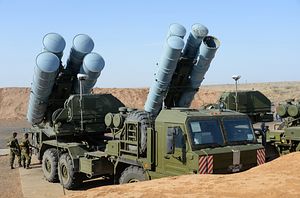A senior U.S. diplomat in a recent congressional testimony expressed deep concerns over India’s decision to procure five squadrons of Russian-made Almaz-Antei S-400 Triumf air defense systems (NATO reporting name: SA-21 Growler) for service in the Indian Air Force (IAF).
U.S. Principal Deputy Assistant Secretary for South and Central Asia Alice Wells said in an official testimony before the U.S. House of Representatives House Foreign Affairs subcommittee on June 13 that the purchase of the S-400 defense systems could limit burgeoning India-U.S. military relations.
The induction of the new long-range air defense systems “effectively could limit India’s ability to increase our own interoperability,” according to Wells, adding that the United States has “serious concerns” about the long-term strategic implications of the purchase for U.S.-India ties.
“At a certain point, a strategic choice has to be made about partnerships and a strategic choice about what weapons systems and platforms a country is going to adopt,” Wells said.
India and Russia signed a $5 billion contract for the procurement of five S-400 squadrons during last year’s annual bilateral summit held in New Delhi in early October. Indian Prime Minister Narendra Modi and Russian President Vladimir Putin presided over the signing ceremony. The first S-400 squadron is expected to be stood up by the fall of 2020.
The Modi government has persisted in its decision to purchase the Russian-made S-400s despite strong opposition from the United States and the possible imposition of economic sanctions on India under U.S. legislation known as the Countering America’s Adversaries Through Sanctions Act (CAATSA). The legislation seeks to economically and financially punish countries engaging in “significant transactions”–defined as any deals above $15 million–with the Russian state-owned defense industry.
While the Trump administration has been given authority under the 2019 U.S. National Defense Authorization Act (NDAA) to waive sanctions in special cases it is far from clear whether India would be able to obtain exempt status. For one thing, sanction waivers have originally been reserved for cases of Soviet-era hardware costing less that $15 million and not for modern and more expensive platforms like the S-400.
“There is no blanket waiver, or a country waiver, when it comes to S-400, Wells cautioned. “We have serious concerns about a possible S-400 purchase, and we are continuing our conversations on how the United States or other defense providers could assist India.”
Notably, in September 2008, the United States imposed sanctions on the People’s Liberation Army’s (PLA) Equipment Development Department (EDD) for China’s induction of S-400 systems and Sukhoi Su-35S (NATO reporting name: Flanker-E) fourth generation, twin-engine, multirole fighter aircraft.
“Under the Trump administration, we’ve been very clear that we’re ready to help meet India’s defense needs and we are seeking a very different kind of defense partnership building on the ‘Major Defense Partner’ designation that India has received from Congress,” Wells noted.
The U.S. has reportedly offered India the MIM-104F Patriot (PAC-3) surface-to-air missile defense system and the Terminal high Altitude Area Defense (THAAD) system in lieu of the S-400.
Wells testimony comes ahead of U.S. Secretary of State Mike Pompeo’s visit to India later this month.
































